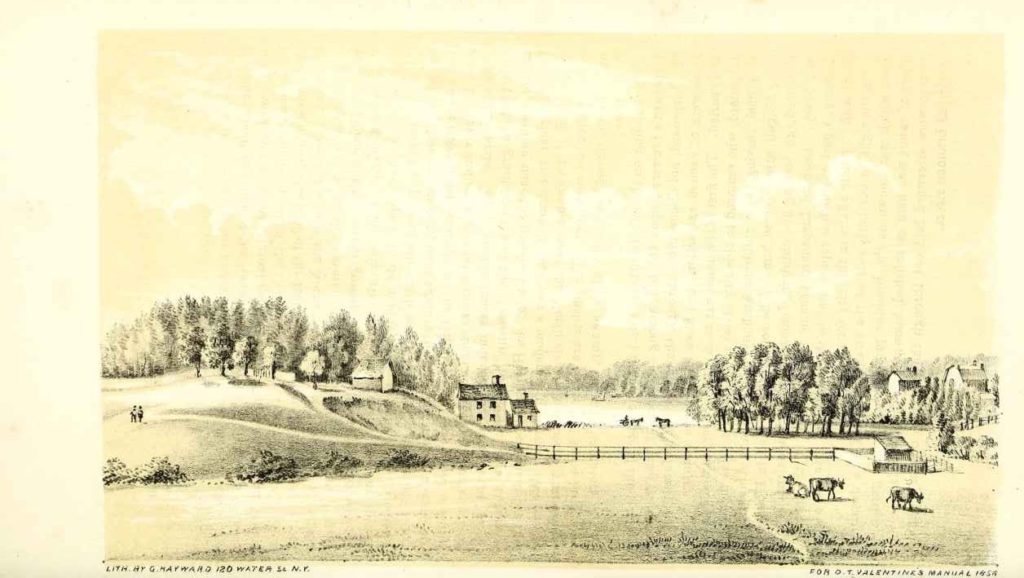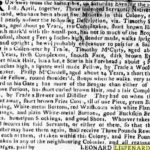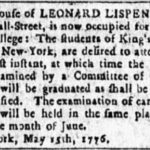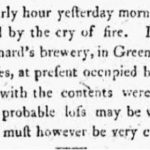Lispenards. For a few days I have had Lispenards on the mind. We’ve seen them before. I’ve actually had them on the mind for years. In Upper Hudson Valley Beer, Craig and I wrote this:
After the war was won and New France conquered in 1760, William Johnson continued to import beer into his western Albany County estate but the records indicate that his choices were not local. He is buying Taunton ale from England as well as beer by the New York City brewer Lispenard. It may reflect his further increased wealth as he is also seeking out port wine and New Jersey cider from his southern supplier, the merchants Hugh & Alexander Wallace. Their invoice to Johnson dated Nov. 3, 1772, shows the extent he would go to pour himself and his guests the range of beers he desired:
6/-/- for 3 Barrl Strong Beer at 40/
4/10/- for 3 Barrl. Ale @ 30/
1/7/- for 6 Barrels at 4/6
7/-/- for 10 Barrels Newark Syder at 14/
0/3/- for Carting ale to the Sloop.
I got deeper into that order placed by William Johnson or rather Sir William Johnson, 1st Baronet of New York and one of the richest, most powerful men in British North America back in 2010 but suffice it to say that what Johnson was buying was the best he could get. And that included Lispenard’s ale.
What, you might ask, was a Lispenard? As the perpetually excellent Colonial Albany Project tells us, the family was founded in the New World by Anthony Lispenard of La Rochelle France who emigrated in 1669 when he was 29 and lived along the Hudson River for the remaining 27 years of his life in 1696. He was a baker, a trader and a government official including Albany’s Viewer of the Corn from 1689. In the Manual of the Corporation of New York for 1856, this founder of the clan, Anthony, was also identified as a brewer. He left three children: Margaret, Abigail and their unhelpfully named brother Anthony. Anthony Lispenard the younger himself passed away leaving not so much in the records department but three children including a son – Leonard born in the 1714 who inherited the family’s estate.
He led a prosperous private and an important public one, too. He also married well and through his wife Alice or Elsie Rutgers came into possession of one third of a grant made by George II to her father, Anthony Rutgers, which they then expanded then named Lispenard meadows and then built a mansion next door on Lispenard hill – all near a swampy area that then sat in the middle of Lower Manhattan in the area is now part of Tribeca. You can seek these lands identified as “King’s Farm” on this map from 1729. As part of his estate, Anthony Rutgers owned “large breweries and mills located on the North River (as the southern branch of the Hudson west of Manhattan was known) not far from the foot of Cortlandt Street His son-in-law, Leonard, continued the brewing operations. They had children including the unhelpfully named Leonard born in 1743 and, yes, his brother… another Anthony. Rutger’s / Lispenard’s brewery is shown above as it was about 1776 according to Manual of the Corporation of New York for 1856.
It gets a bit trickier now. Not because of all the Anthonys. Because of the Leonards. Father and son are both fairly prominent in New York City before, during and after the Revolution. They show up in the news papers. In The New York Mercury of 22 April 1765, a notice was posted on behalf of Leonard Lispenard requesting the return of three indentured servants who had been in the colony for about five months. One, Phillip M’Cardell, was described as being by trade a brewer and distiller. One of the two Leonards was employing brewers. Another notice was placed in the General Advertiser dated 15 May 1776 stated that the house of Leonard Lispenard, Esq in Wall street was being occupied by students of King’s College. Despite such seeming Loyalist credentials, three months later on 17 August, George Washington issued an order that guards be mounted day and night at Lispenard’s brewery. Lispenard Senior (aka 1714-1790) had already thrown his lot into the Revolution. He was a member of the colony’s Committee of Correspondence in 1774 and backed Washington publicly on his return to New York City in 1775 and likely a Son of Liberty.
Anthony, brother of Leonard Junior (aka 1743-1800), takes off in the brewing business in his own right. He marries one Sarah Barclay in 1764 and becomes “the proprietor of the extensive breweries on the Greenwich road, near the foot of Canal Street.” I am guessing that this is the Lispenard that Sir William Johnson buys beer from through agents in 1772. In the 1 June 1791 edition of the New York Daily Gazette, a notice was placed under the headline “Brewery, North-River” which stated that Anthony Lispenard had taken his son – yes, of course.. because there was no other choice – Leonard into partnership. Note this map from 1783. Notice that they are still described as sitting on the Hudson. Shipping beer on the Hudson. And father and son – Anthony and Leonard – were inviting orders for porter, ale or table beer. The address for Leonard was given as 15 King Street. This Leonard traveled to England shortly after end of the American Revolution in 1783, and remained some years in London with the Barclays, relatives of his mother and founders of the famous breweries. On 10 December 1804, a short news item appeared in the The Daily Advertiser from New York stating:
At an early hour yesterday morning the city was alarmed by the cry of fire. It proved to be at Lispenard’s brewery, in Greenwich-street. The premises, at present occupied by Mr. John S. Moore, with the content were destroyed. What the probably loss may be we have not learned; it must however be very considerable.
An article in the Commercial Advertiser from the same date stated an entire wing of the building had been destroyed. Notice in the upper left of this map from 1789 how the Lispenard estate sits on the road to Greenwich.
The family name fades. Sons die childless. No one gets named Anthony or Leonard. The next generations in the 1800s also appear to lose interest in brewing. In 1907, the remains of Leonard Lispenard (1743-1800) were uncovered as part of a construction site. A report in The New York Times from 9 April of that year details the find as well as some of the family’s legacy. He had been buried near the farm in New Rochelle near where his great grandfather, the original Anthony, had settled after moving south from Albany. A street is still named after them.






Translation of the comment in German offered by Horst as set out lower down: “The people of Bayreuth fought together with the people of Ansbach on the side of England in the War of Independence. The Lispenard Brewery in New York was the Bayreuthers’ quarters. Period approx. 1778-1781. Johann Lochner, the cousin of my great-grandfather’s great-grandfather, was there Bayreuth troops. He died in hospital in New York in February 1782. The Ansbachers were housed just outside of New York.”
————-
Die Bayreuther kämpften zusammen mit den Ansbachern auf der Seite Englands im Unabhängigkeitskrieg. Die Lispenardsche Brauerei in New York war das Quartier der Bayreuther. Zeitraum ca. 1778- 1781. Johann Lochner, der Cousin des Urgroßvaters meines Urgroßvaters war mit bei den Bayreuther Truppen. Er starb im Februar 1782 im Krankenhaus in New York. Die Ansbacher waren etwas außerhalb von New York untergebracht.